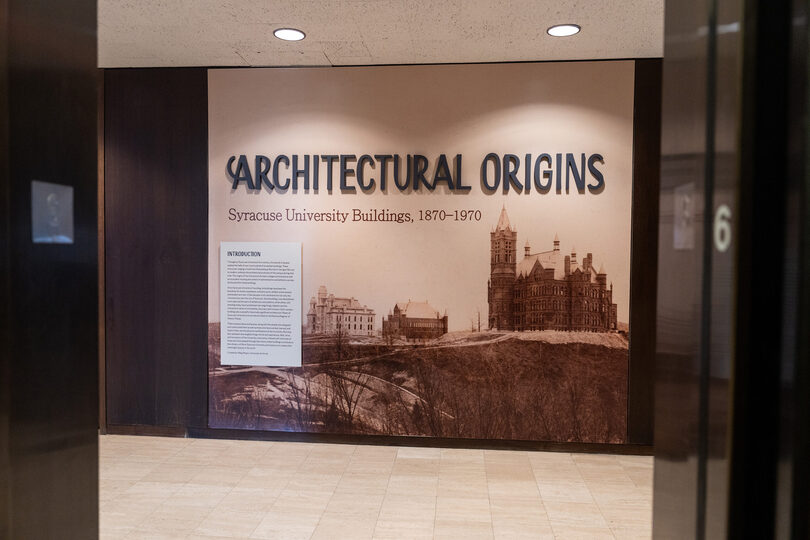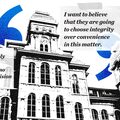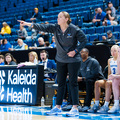SCRC’s fall exhibition details old photographs, designs behind campus history

The Special Collections Research Center exhibit featured buildings like Newhouse 1, the Women’s Building, and Hall of Languages. The exhibit includes blueprints, aerial photos and other historical items. Collin Snyder | Staff Photographer
Get the latest Syracuse news delivered right to your inbox.
Subscribe to our newsletter here.
Meg Mason’s favorite piece in the new Special Collections Research Center is a teapot with Syracuse University painted on it. She thinks the teapot was originally sold in the SU Campus Store or a local souvenir store.
Mason enjoys finding items like this because they tell a story about the time and place they were made or sold.
“These all give you not only a different perspective, but also they’re providing all this kind of different information to give you a sense of what happened,” Mason, head curator of the SCRC’s fall exhibition, said.
“Architectural Origins: Syracuse University Buildings, 1870-1970” is on display on the sixth floor of Bird Library until Jan. 6. The exhibition combines images of blueprints, photographs, materials and other objects, focusing on iconic SU buildings.
Much of the exhibition centers around the visual representation of important buildings on SU’s campus. This was achieved by displaying photos and blueprints on the gallery’s walls alongside three-dimensional models or archival documents.
The exhibition includes a main gallery with a focus on early buildings from the 1870s onward, and a small gallery focusing on buildings built in the 1960s and ‘70s. Some buildings featured in the exhibition include the Hall of Languages, Newhouse 1 and the Women’s Building.
Mason said the wide variety of archival materials related to university buildings made the process of choosing which buildings to display difficult. After that, narrowing down the buildings to highlight in the main gallery of the exhibition was even harder because of limited space.
The head curator decided to include buildings based on their importance to SU’s history. The HoL, she said, was a necessary piece to include due to its importance as the first building on campus. She also included Newhouse 1 because of its historically significant dedication by former U.S. President Lyndon B. Johnson.

The SCRC exhibit featured miniature models of familiar Syracuse University buildings. Newhouse 1 was featured because of the historical significance of its dedication by Lyndon B. Johnson. Collin Snyder | Staff Photographer
It was important for the exhibition to not feature repetitive images, Mason said. Though an image of the building might be included, they created variety by using a photograph of the construction or an aerial view of the building.
Anna Shuff, an SU graduate student of library and information science, contributed to the exhibition by researching and fact-checking. Shuff has been working on SCRC exhibitions since she began working at Bird. Her favorite part about working on this exhibition was learning more about the buildings.
“As a grad student, you kind of end up sticking to the areas where your classes are because you’re not living on campus and all of that,” Shuff said. “So it was fun to get a sense of that history.”
Shuff said working on the exhibition gave her insight into a future career as an archivist. She finds curation work rewarding, and is excited to potentially curate her own exhibition someday.
Sophomore Nina Sverika, visited the exhibition on its opening on Sept. 4. Sverika said she enjoyed learning about how Slocum Hall used to house the School of Architecture.
“I really liked getting to see images and read stories about Syracuse’s past, because I think that a lot of people don’t know where the school came from, necessarily,” Sverika said. “And it’s really cool that we have all that history within our archives that people get to see.”
Shuff also enjoyed the architectural models featured in the exhibition.
“I’ve always really loved little miniature things,” Shuff said. “So I found those really neat as a small-scale version of a larger building, I also think they’re very visually interesting and they’re fun to have.”
Mason’s favorite story from the archive is about the Women’s Building. Compared to other buildings funded by wealthy donors, Mason said, the Women’s Building was funded by female students and alumni of the school. They raised money by selling hot dogs or through other fundraisers.
Although there was no special anniversary for this exhibition, Mason thought that students asking questions about campus buildings made for good conversations.
“My favorite part about archiving is finding different collections, different types of materials, to tell a story,” Mason said. “Together, they help you tell you the whole story.”






